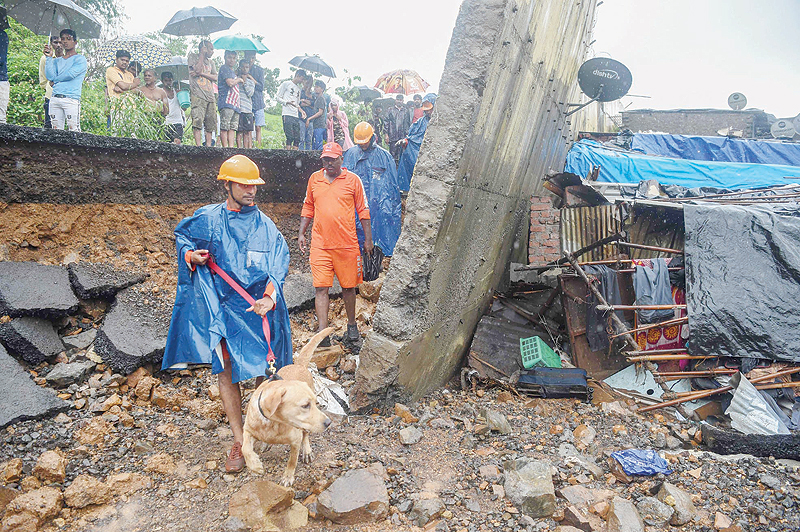MUMBAI: At least 21 people were killed in Mumbai yesterday when a wall collapsed as the heaviest monsoon rains in a decade brought chaos to India's financial capital and surrounding areas. Scores more were injured when the structure came down around 2:00 am in a slum, said Tanaji Kamble, a disaster management spokesman for Mumbai's local authority. The tragedy came as the teeming coastal settlement of 20 million residents was lashed by heavy rains for a second consecutive day, bringing the city to a virtual standstill.
Authorities declared yesterday a public holiday and advised all residents to stay indoors. Schools and colleges were closed while more than 100 flights were either cancelled or diverted from Mumbai airport. The airport's main runway was shut after a SpiceJet plane carrying 167 passengers and crew overshot it shortly before midnight Monday. "Currently secondary runway is in use, our team is trying their best to bring the main runway back in operation and this may take up to 48 hrs," the airport tweeted.
According to Skymet Weather, a private weather-tracking agency, large swathes of Mumbai received around 350 mm of rain overnight into yesterday morning, the most in a decade. The deluge left low-lying areas submerged. "Everything around us is flooded. It's scary and the problem persists every year despite government promises," Vishal Agawane, a 32-year-old resident of the Dharavi slum, told AFP. Around 1,000 people living close to the city's Mithi river were evacuated to higher ground as it threatened to burst its banks, said Kamble, the disaster management spokesman.
Train services on Mumbai's colonial-era rail network, a lifeline for the city's population, were disrupted due to waterlogged tracks, while motorists were seen pushing cars through flooded streets. Rescuers were sifting through the debris of the wall that collapsed in a slum area in Mumbai's north, in the hope of finding more survivors trapped under rubble. The dead included a 10-year-old girl, who was trapped alive under the debris for hours before rescuers pulled out her body in a 12-hour-long unsuccessful operation. A local rescue volunteer earlier in the day told the NDTV channel that they heard the girl crying in pain and begging for water.
Building collapses are common during the monsoon, when dilapidated structures buckle under the weight of continuous rain. Three people, including a toddler, were also killed yesterday in Thane district, which borders Mumbai, when a wall collapsed at a school. Two waiters were electrocuted after rainwater gushed into a restaurant and came in contact with a live wire in Thane. Another person was critically injured. And six laborers died near the western city of Pune, 150 km from Mumbai, when a wall fell onto their makeshift shacks. At least 15 laborers died in a similar accident on Saturday.
Mumbai's streets regularly flood during the monsoon, which runs from June until September or October, and which provides India with most of its annual rainfall. In 2005, 950 mm of rain fell on the coastal metropolis in just 24 hours, killing more than 500 people. In August 2017, intense rainfall brought the commercial hub to a virtual standstill for two days and left at least 10 people dead.
Activists say Mumbai's susceptibility to floods has worsened in recent years due to a construction boom that is trying to keep up with the city's swelling population. Much of Mumbai's mangrove cover, which helps drain water, has been destroyed over the past decade to make way for glitzy high-rises. According to various studies, anywhere between 40 to 50 percent of the city's population live in slums, which become a sea of blue tarpaulin every monsoon as residents try to keep out the rain. - AFP










